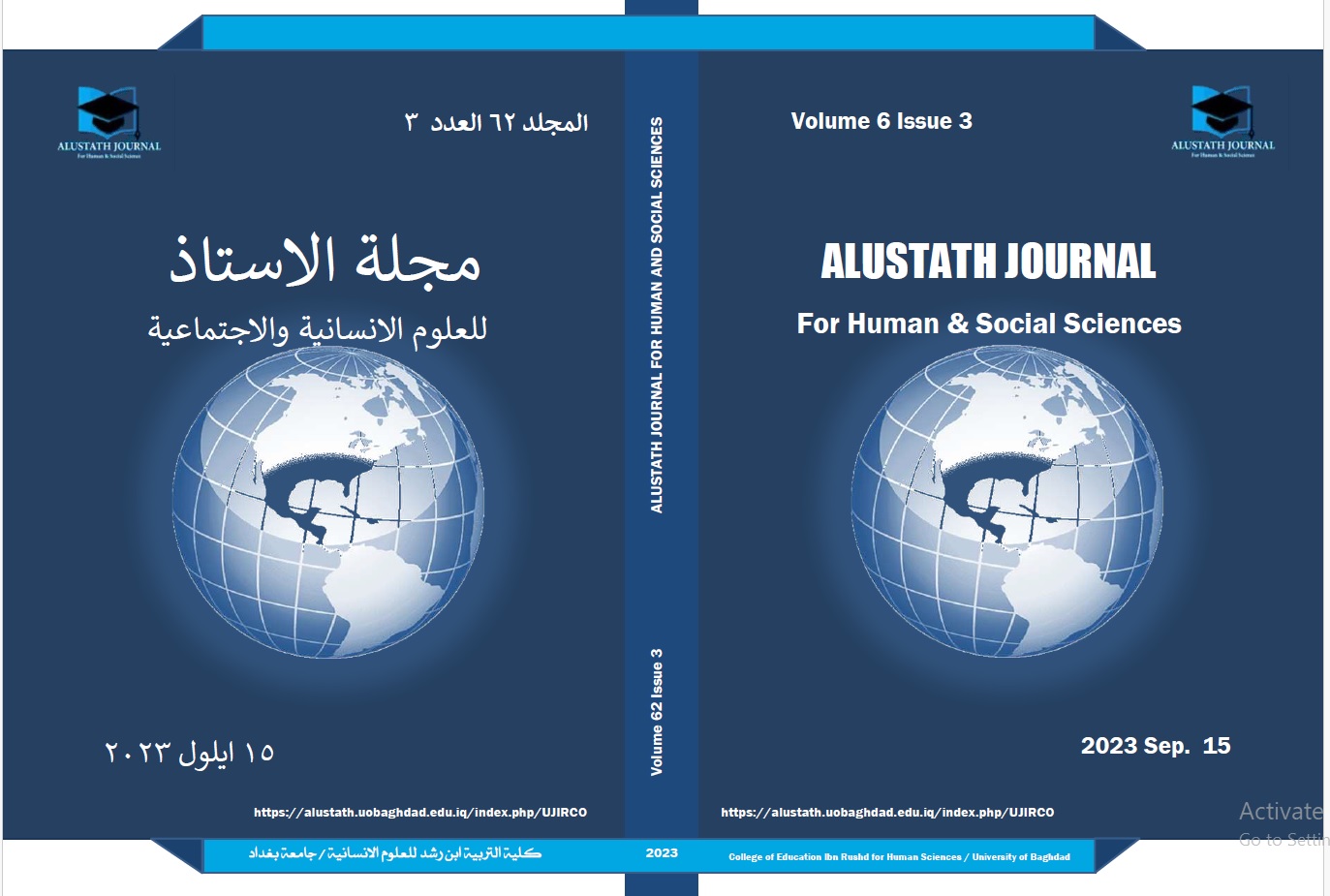الذكوريه والدور الجنسي في قصص مختاره لهاروكي ماروكمي
DOI:
https://doi.org/10.36473/ujhss.v62i3.2167الكلمات المفتاحية:
الحنين الى الماضي ، الحوار ، الذكوره، المراسلات، موراكاميالملخص
هاروكي موراكامي (1949) روائي ياباني يستخدم الخيال لتصوير حالة الإنسان الحديث. الهوية الجنسية والشعور بالوحدة والحنين هي مواضيع شائعة في أعماله. رجال بلا نساء (2014) هي مجموعة من القصص القصيرة التي يعكس فيها موراكامي أدوار الجنسين لإظهار سعي الرجال اليائس للرفقة في حياتهم. وفقا لهانز روبرت جاوس (1921-1997)، وهو منظر أدبي ألماني، لا يوجد تفسير متطابق لأي نص أدبي .ومع ذلك، هناك نوع من المراسلات الحوارية بين النص والقارئ. وهذا يسمح لصوت القارئ ببث حياة مختلفة في النص. لذلك تهدف هذه الدراسة إلى توضيح أزمة الهوية في مجتمع محافظ مثل اليابان. حيث يُظهر أسلوب موراكامي الخام تأثير الضغط الاجتماعي وعزلة الذكورة في مجتمعات ما بعد الحداثة.
التنزيلات
المراجع
ALTIOK, R. E. V. N. A. (2022, June 23). What Is Mukokuseki in Anime – And Why Is ItImportant? Www.Cbr.Com. Retrieved July 12, 2022, from https://www.cbr.com/mukokuseki-no-nationality-importance-in-anime/
Al-Zubaidi, N. a. G. (2019b). Woman Stereotypes and Patriarchal Hegemony: A Feminist Stylistics Analysis of Iraqi Folk Proverbs. Alustath Journal for Human and Social Sciences, 58(1), 67–84. https://doi.org/10.36473/ujhss.v58i1.836
Author, N. (2022, March 3). Japan sees record number of domestic violence consultations amid pandemic. The Japan Times. Retrieved June 7, 2022, from https://www.japantimes.co.jp/news/2022/03/03/national/crime-legal/domestic-violence-2021/
Chandra, S. (2018, August 6). The psychology behind why you always want to sit in the same seat. Quartz. https://qz.com/1349508/the-psychology-behind-why-you-always-want-to-sit-in-the-same-seat/
Faculties and Departments. (n.d.). Kyoto Women’s University. Retrieved October 26, 2022, from https://www.kyoto-wu.ac.jp/english/about/faculties.html
Fan, T. (2019). The Analysis of Female Images in Japanese Literary Works from the Perspective of Culture. International Conference on Humanities, Cultures, Arts and Design, 298–302.
Fejer, A. N. (2018). Witchcraft and Women’s Spaces; A cultural Materialism Study of John Updike’s The Witches of Eastwick. Alustath Journal for Human and Social Sciences, 215(1), 133–158. https://doi.org/10.36473/ujhss.v0i215.61
Haruki Murakami | Biography, Books and Facts. (2013, July 26). FAMOUS AUTHORS. Retrieved March 19, 2022, from https://www.famousauthors.org/haruki-murakami
Iser, W. (1974). The Implied Reader: Patterns of Communication in Prose Fiction from Bunyan to Beckett. Johns Hopkins University Press.
Jarmuth, A. (2020, December 17). Understanding Japan’s Gender Inequality. Institute for Security and Development Policy. Retrieved June 7, 2022, from https://isdp.eu/understanding-japans-gender
Jauss, H. (1982). Toward an Aesthetic of Reception (Volume 2) (Theory and History of Literature) (First edition). Univ Of Minnesota Press.
Jauss, H. (2010). The changed in the paradigm of literary scholarship. In R. C. Holub (Ed.), Reception Theory (New Accents) (1st ed., pp. 25–55). Routledge.
Kaynar, A. ı. İ. (2019). Tanizaki Jun’ichirō’s Modern Girls: Reversing the Role of Moga in Japanese Literature. Boğaziçi University, Asian Studies Center, MAAS, 43–63.
Kent, T. L. (1986). Interpretation and Genre: The Role of Generic Perception in the Study of Narrative Texts. Bucknell University Press.
Khalaf, R. J., & Diyaiy, S. A. (2019). The Split Identity in Brain Friel’s Play PHILADELPHIA, HERE I COME! ). الاستاذ, 58(4), 25–32. https://doi.org/10.36473/ujhss.v58i4.1016
Literary Hub, L. H. (2020, May 8). A Feminist Critique of Murakami Novels, With Murakami Himself. Literary Hub. Retrieved March 20, 2022, from https://lithub.com/a-feminist-critique-of-murakami-novels-with-murakami-himself/
Mambrol, N. (2016b, November 2). Reception Theory: A Brief Note. Literary Theory and Criticism. Retrieved March 3, 2022, from https://literariness.org/2016/11/02/reception-theory-a-brief-note/
Mambrol, N. (2019, April 8). Analysis of Haruki Murakami's Novels. Literary Theory and Criticism. Retrieved February 10, 2022, from https://literariness.org/2019/04/08/analysis-of-haruki-murakamis-novels/
Margolis, E. (2019, October 15). What’s Up With Bad Sex in Murakami? | Books. Metropolis Japan. Retrieved March 22, 2022, from https://metropolisjapan.com/sex-haruki-murakami/#:%7E:text=Laidi%20Kirsta%20analyzes%20on%20BookFury,with%20some%20kind%20of%20prostitution.
Murakami, H., Gabriel, P., & Goossen, T. (2017). Men Without Women: Stories. Van Haren Publishing.
Pedersen, M. (2018). The fascination with the ‘dangerous’ female Orient Geishas in the Western imagination vs. the Japanese reality. Researchgate., 1–8. https://doi.org/10.13140/RG.2.2.12529.84320
Postwar Japanese literature, a brief survey of the field – Teaching Postwar Japanese Fiction. (2016, May). MLA Visitor. Retrieved March 19, 2022, from https://teachingpostwarjapanesefiction.mla.hcommons.org/about-this-volume/postwar-japanese-literature-a-brief-survey-of-the-field/
Ritner, J. (2018, December 5). Confucian Patriarchy and the Allure of Communism in China. Not Even Past. Retrieved March 24, 2022, from https://notevenpast.org/confucian-patriarchy-and-the-allure-of-communism-in-china/
Shōnagon, S. (2020, February 28). Sei Shōnagon: Why Gender Stereotypes of an Ancient Woman Writer Still Resonate Today. Columbia University Press Website. Retrieved January 2, 2022, from https://cupblog.org/2019/03/18/sei-shonagon-why-gender-stereotypes-of-an-ancient-woman-writer-still-resonate-today/
Silva, M. A. (2010, September 1). Women in Ancient Japan: From Matriarchal Antiquity to Acquiescent Confinement. Inquiries Journal. Retrieved March 25, 2022, from http://www.inquiriesjournal.com/articles/286/women-in-ancient-japan-from-matriarchal-antiquity-to-acquiescent-confinement
Snyder, S. (2017, January 4). The Murakami Effect. Literary Hub. https://lithub.com/the-murakami-effect/
Strecher, M. C. (2014). The Forbidden Worlds of Haruki Murakami (First ed.). Univ of Minnesota Press.
Teel, A. (2017, May 3). The Application of Stuart Hall’s Audience Reception Theory to Help Us Understand #WhichLivesMatter? Medium. https://medium.com/@ateel/the-application-of-stuart-halls-audience-reception-theory-to-help-us-understand-whichlivesmatter-3d4e9e10dae5
Vasile, A. (2012). Cat imagery in Haruki Murakami’s fiction. Editura Pro Universitaria, 159–174. https://www.ceeol.com/search/article-detail?id=61893












